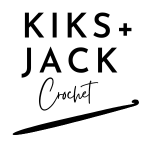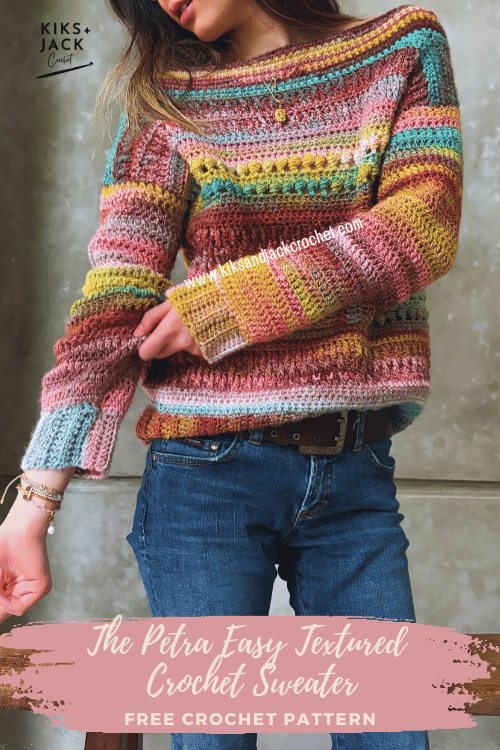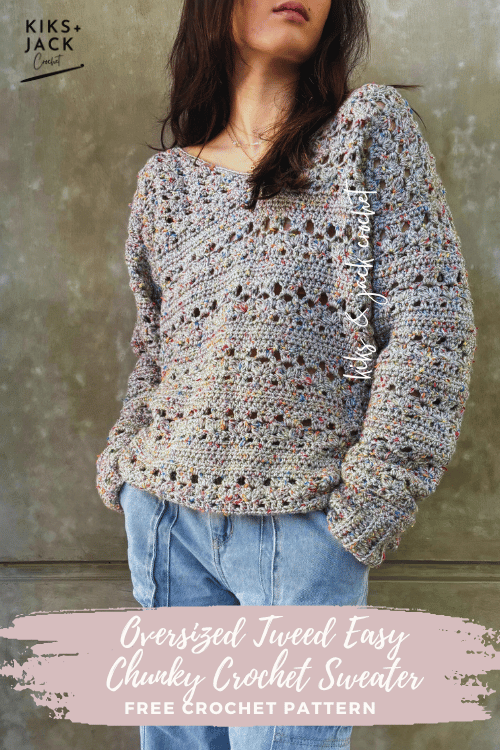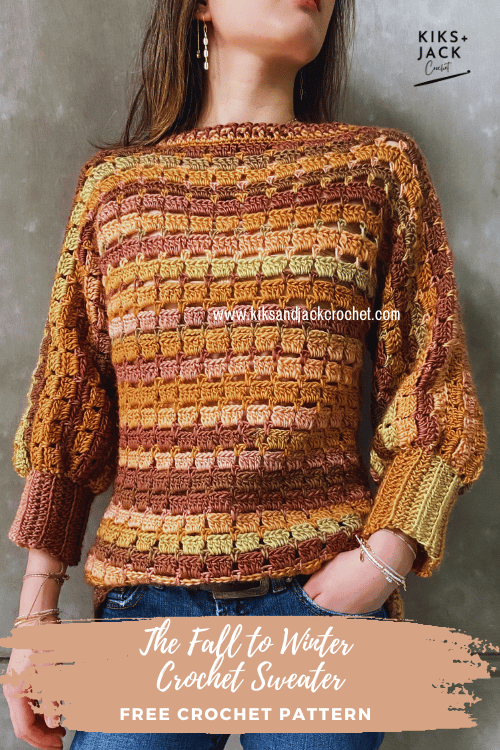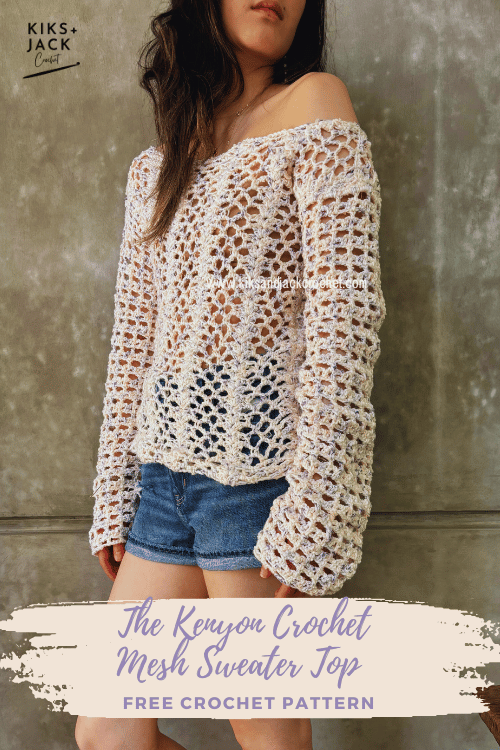The Petra Easy Textured Crochet Sweater is a crochet pattern for you to view for free below. It is made to measure, size inclusive and designed and written specifically for beginners.
We are trying to keep all our crochet patterns free for everyone, when you access them online. We meet the costs of running this website through coffee donations at https://ko-fi.com/kiksandjackcrochet and ad revenue. When you buy us a cup of coffee, you buy us a cup of motivation. Thank you for keeping us motivated and inspired every day to keep designing free crochet patterns for you.
The Petra Easy Textured Crochet Sweater started with the purchase of beautiful unique yarn from a small market yarn store. There was something so special finding this little yarn store tucked away in the corner after purchasing good coffee, shortbread and house plants. It was the perfect ending to a lazy sunny afternoon.

After we purchased this yarn it actually then sat on our design desk for a few months. I think all the memories of that awesome market afternoon, made us really want to design something special with this yarn. Something that would bring back all the great memories when we wore it.
Do you have special memories associated with specific yarns that you find? The amazing thing about crocheted garments is that each garment tells a story. It’s so much more than the sweaters we purchase at the big box stores!
The Petra Easy Textured Crochet Sweater incorporates some of our favourite stitches. The bead stitch, the half double crochet and alternating front post triple crochet. We also wanted to crochet an interesting yoke neckline using simple half double crochet stitches. Have you ever crocheted something with the front post triple crochet stitch? We love this stitch and would love to crochet an entire sweater out of it next!

So now to the yarn! We used Sirdar Jewel Spun. It’s a weight 4/worsted/medium and the colours in this range are gorgeous. You will be guaranteed to crochet something that is uniquely yours and never found in a store! Each skein is a generous 200g so this sweater was made using only 2 skeins.
If you are looking for other textured crew neck sweaters that are similar to the Petra Easy Textured Crochet Sweater, consider The Classic Cropped Crochet Sweater and the Wide Shoulder Crochet Sweater.
It would be amazing to see a photo of your work in progress for the Petra Easy Textured Crochet Sweater. Click on the icons below to follow us on social media @kiksandjackcrochet.
DESCRIPTION of The Petra Easy Textured Crochet Sweater
The Petra Easy Textured Crochet Sweater is a stunning textured sweater that uses primarily three different stitches. Although the change in stitches look complex they are actually quite simple and keeps the Petra Easy Textured Crochet Sweater interesting motivating you to crochet to completion.
This design has some positive ease although it is not hugely oversized. This sweater features ribbing at the bottom and ribbing on the sleeves. The neckline is crocheted wide and then rows of half double crochet stitches are crocheted around giving it an interesting yoke. The neckline can be customized wider or tighter.
The Petra Easy Textured Crochet Sweater is a free and easy crochet pattern available as a size inclusive made to measure pattern. It is an advanced beginner pattern.
CROCHET MEASUREMENTS & SIZES
The Petra Easy Textured Crochet Sweater pattern instructions are made to measure, based on your required measurements.
Kiks + Jack Crochet will always try to write patterns that are “made to measure” (versus graded sized patterns) so that crocheters can get the wonderful benefits of making a garment that fits perfectly. However we do appreciate taking measurements can be inconvenient for some and have also provided standard measurements for those who wish to use it.
To use The Petra Easy Textured Crochet Sweater pattern you will need the following measurements and you should write them down for easy reference:
Chest/Bust: Measure around the fullest part of your chest/bust. Do not draw the tape too tightly.
Finished length: Measure from just below the waist (or where you would like the sweater to end) up to the top of your shoulder at your collarbone.
Arm Length: Measure from armpit to wrist (or where you would like the sleeve to end)
Upper Arm: Measure around the widest section of the upper arm located above the elbow
Wrist Circumference: Measure from one point on your wrist all around your wrist. Do not draw the tape too tightly.
Standard Measurements (For Reference)
If you would like to use standard sizing for the chest/bust – then for XS (S, M , L, XL, 2XL, 3XL, 4XL, 5XL) use approximately 28-30 (32-34, 36-38, 40-42, 44-46, 48-50, 52-54, 56-58, 60-62) inches or 71-76 (81-86, 91-96, 102-107, 112-117, 122-127, 132-137, 142-147, 152-158) centimetres.
If you would like to use standard sizing for arm length – then for XS (S, M , L, XL, 2XL, 3XL, 4XL, 5XL) use approximately 16.5 (17, 17, 17.5, 17.5, 18, 18, 18.5, 18.5) inches or 42 (43, 43, 44.5, 44.5, 45.5, 45.5, 47, 47) centimetres
If you would like to use standard sizing for upper arm – then for XS (S, M , L, XL, 2XL, 3XL, 4XL, 5XL) use approximately 9.75 (10.25, 11, 12, 13.5, 15.5, 17, 18.5, 18.5) inches or 25 (26, 28, 30.5, 34.5, 39.5, 43, 47, 49.5) centimetres
Note: The Petra Easy Textured Crochet Sweater is designed as classic fit with some positive ease.
CROCHET GAUGE for The Petra Easy Textured Crochet Sweater
Note: The Petra Easy Textured Crochet Sweater pattern is made to measure and can accommodate for different crochet gauges. However we suggest you select a yarn with a similar weight and use a similar sized hook to our version.
We used a hook size 5 (US size 8), and a weight 4 yarn.
CROCHET MATERIALS for The Petra Easy Textured Crochet Sweater
This section contains product affiliate links. We may receive a small commission (at no extra cost to you) if you make a purchase after clicking on one of these links.
We promise to only recommend products that we love and that we use. Thank you for supporting our small business.
Yarn brand: Jewelspun Aran by Sirdar. Weight 4/Worsted/Medium. 200g per skein and 546 yards (or 500m) per skein.
You can also purchase Jewelspun by Sirdar on Amazon here.
We used Glacier.
Approximately 2 skeins or 390 grams and 1065 yards (or 975 m) used for Kiks + Jacks version with a finished width of 18 inches and a finished length of 22 inches.
5 mm crochet hook (US size 8). We use many different crochet hooks and if you are looking for some great budget friendly ergonomic crochet hooks try these from Amazon. It comes in a set and the grip and the shape is amazing for beginner crocheters. We also love the slightly more pricey crochet hooks from Clover Crochet Hooks and the beautiful Furls Crochet Hooks (these are so stunning, we just love looking at them!)
Measuring Tape. We use a super budget friendly measuring tape. Make sure it has cm and inches (not all patterns are written with both). We are always crocheting on the go so we like our tapes small and compact and we put one in our design area, one in our bag and one in our car. Retractable works best! We use these super cheap mini measuring tapes from Amazon (we love the pastel colours).
Stitch Markers. We use these locking crochet stitch markers from Amazon and these stitch markers that do not lock. They are cheap and colourful.
Blocking Pins. You should buy more pins than you think you need. If you are going to take the time to block don’t skimp on the pins. We like T shaped stainless steel pins that don’t rust when they get wet. We love these blocking T pins from Amazon and the tin means the pins don’t fall out on the floor.
Yarn Needle. Buy blunt needles with large eyes for yarn. We use these Yarn Needles because we like the convenient bottle, they are budget friendly and we get lots of them!
Scissors. We love these thread snippers because they are cheap, we get two of them AND they come with a case (some don’t). Don’t carry these without the case! After you use thread snippers you won’t want to snip with scissors.
CROCHET STITCHES & ABBREVIATIONS
The Petra Easy Textured Crochet Sweater pattern is written with US terms.
ch = chain (With one loop on your hook, yarn over and pull through the loop)
sc = single crochet (Insert hook into desired stitch. Yarn over and pull through the stitch. You now have two loops on your hook. Yarn over and pull through all two loops)
hdc = half double crochet (Yarn over and insert hook into desired stitch. Yarn over and pull through the stitch. You now have three loops on your hook. Yarn over and pull through all three loops)
dc = double crochet (Yarn over and insert hook into desired stitch. Yarn over and pull through the stitch. You now have three loops on your hook. Yarn over and pull through the first two loops. You now have two loops on your hook. Yarn over and pull through all two loops)
fptc = front post triple crochet (Yarn over twice and insert your hook from the front side to the back side of your work around the desired double crochet – the post – from the previous 2 rows, coming up on the opposite side of the stitch. [Yarn over and draw through 2 loops] x 3 times)
Bead Stitch (BS): 1dc into the required st. *Yarn over, insert hook behind the post of the dc from right to left, and pull up a loop. You should have 3 loops on the hook. Repeat * one more time around the same dc post. You should now have 5 loops on the hook. Repeat * one more time around the same dc post. You should now have 7 loops on the hook. Yarn over and pull through first 6 loops. Yarn over and pull through remaining 2 loops on hook.
hdc2tog = half double crochet 2 stitches together (Yarn over and insert hook into desired stitch. Yarn over and pull through the stitch. You now have three loops on your hook. Yarn over and insert hook into next stitch. Yarn over and pull through the stitch. You now have five loops on your hook. Yarn over and pull through all the loops) There are a number of ways to crochet a hdc2tog, however I find this way is great for beginners. Feel free to use another technique for hdc2tog if that works better for you.
sl st = slip stitch (Insert hook into desired stitch. Yarn over and pull through the stitch and the loop on your hook)
BLO = back loop only
ch-3 sp = chain 3 space (eg. crochet into the space and not the stitch)
tch = turning chain
st = stitch
sk = skip stitch
* = repeat the instructions following the * as directed
Note unless stated otherwise turning chains do not count as a stitch if there are 1 or 2 chains and the turning chain does count as a stitch if there are 3 or 4 chains.
SUMMARY of CONSTRUCTION for The Petra Easy Textured Crochet Sweater
The Petra Easy Textured Crochet Sweater is made by first crocheting a back panel and an identical front panel. We will crochet the panels bottom up starting with an bottom ribbing and end with the neckline. After we have created the two panels, we will crochet the sleeve panels starting with the ribbing for the sleeves. We will then continue to crochet the sleeves on to the ribbing. Next we will seam the front panel and the back panels at the shoulder and then seam the sides and the sleeves directly on to the panels. We will finish by crocheting a large yoke neckline.
PERMISSIONS AND COPYRIGHT
You may not publish or share any pattern on this website www.kiksandjackcrochet as your own including this pattern The Petra Easy Textured Crochet Sweater. Except as permitted by the copyright law applicable to you, you may not reproduce or communicate any of the content on this website, including files downloadable from this website, without the permission of the copyright owner, Kiks + Jack Crochet.
You may not use any Kiks and Jack Crochet photo as your own photo.
You may crochet items to sell using The Petra Easy Textured Crochet Sweater pattern upon permission by email at [email protected]. Please link back to this post in exchange.
Crochet Pattern Instructions for The Petra Easy Textured Crochet Sweater
Crochet the Back Panel Ribbing
ch 12
The height of our ribbing is approximately 2.5 inches. Based on our gauge this is approximately 12 chains. However you can adjust the number of chains if you want to change the height of the ribbing or you are using a yarn with a different gauge.
Row 1: hdc in 3rd ch from hook, hdc in each ch across until end. Turn
Row 2: ch2, hdc BLO in each st across, hdc into the entire stitch on the last st. Turn
Repeat row 2 until the total length of the ribbing is equal to HALF of your “Chest/Bust Measurement” plus 1 inch.
K+J example: Our chest/bust measurement = 32 inches around. Half of 32 inches = 16 inches. We keep repeating row 2 until the total length of the ribbing reaches 17 inches (16 + 1 = 17 inches)
Count the total number of rows.
K+J example: We counted a total of 42 rows to achieve a length of approximately 17 inches.
It’s a great time to check if you are completely happy with the width of the sweater ribbing before you crochet any further. Place the ribbing up against you to see if the width (length of ribbing) is right for you. If you would like it to be wider, crochet a few more rows. If you would like the ribbing to be tighter, then you can frog (unravel) a few rows. Note depending on your gauge, the width may increase slightly.
Do not fasten off.
Crochet the Back Panel
You will now crochet down the long side of the ribbing that you just crocheted.
To calculate the number of stitches that you will crochet down the long side of the ribbing, calculate as follows:
| Calculation | Kiks+Jack Crochet Example |
| Count the number of rows in your ribbing | We have 42 rows in our ribbing |
| Multiply this by 1.5 | 42 X 1.5 = 63 stitches |
| If this number is NOT a multiple of 2 then increase it until it is a multiple of 2 (ie you want an even number). If this number is already a multiple of 2, then leave it as is. | We increase it by one stitch to make 64 stitches |
Row 1: Using the working yarn, ch1, sc into the first st, sc across the ribbing the number of stitches you calculated above in total. Turn
In K+J example above we crochet 64 single crochets across the long side ribbing.
Tip: You may want to place some stitch markers across the ribbing at the 1/4, 1/2 and 3/4 marks. Then divide the number of stitches you need to crochet by 4 to give you a rough idea of how many stitches you need to crochet in each quarter so you can ensure you are crocheting evenly.
Row 2: ch2, hdc into the 1st st, hdc across the row until the end. Turn
Row 3: rep row 2
Row 4: ch3, dc into 2nd st, dc in each st across. Turn
Row 5: ch1, 1sc in 1st st, 1sc in each st across, 1sc in top of tch. Turn
Row 6: ch3, sk first st *1 FPTC around next dc (2 rows below), 1 dc in next sc (you will skip the sc behind the post stitch just made), rep from * across ending with a dc in the last st. Turn
Here are the Front Post Triple Crochet (FPTC) instructions again for your convenience: Yarn over TWICE. Locate the desired double crochet from 2 rows below (the post). Insert your hook from the front side to the back side of your work around the desired double crochet, coming up on the opposite side of the stitch. You are effectively working your hook around the post from front to back. Yarn over and draw through 2 loops. Yarn over and draw through 2 loops again. Yarn over and draw through the 2 loops one final time.
Tip: The Front Post Triple Crochets will look raised and row 6 will look like they are on every 2nd double crochet from the previous two rows.
Row 7: ch1, 1sc in 1st st, 1sc in each st across, 1sc in top of tch. Turn
Row 8: ch3, sk 1st st, *1dc in next st, 1 FPTC around next dc (2 rows below), rep from * across ending with a dc in the last st. Turn
Tip: The Front Post Triple Crochets from row 8 will look like they sit between the FPTCs from the previous row. ie. its an alternating front post triple crochet.
Row 9: ch1, 1sc in 1st st, 1sc in each st across, 1sc in top of tch. Turn
Row 10: rep row 6
Row 11: ch1, 1sc in 1st st, 1sc in each st across, 1sc in top of tch. Turn
Row 12-13: ch2, hdc into the 1st st, hdc across the row, ending with an hdc in last st. Turn
Row 14: ch3, *sk st, BS into next st, rep from * until the end of row finishing with 1dc into the last st. Turn
Here are the Bead Stitch (BS) instructions again for your convenience: 1dc into the required st (don’t forget this step). *Yarn over, insert hook behind the post of the dc from right to left, and pull up a loop. You should have 3 loops on the hook. Repeat * one more time around the same dc post. You should now have 5 loops on the hook. Repeat * one more time around the same dc post. You should now have 7 loops on the hook. Yarn over and pull through first 6 loops. Yarn over and pull through remaining 2 loops on hook.
Row 15: ch1, sc in the 1st st, *sc in st on top of next bead, sc between beads, rep from * across, ending with an sc between the last bead and tch, sc in tch. Turn
Row 16: ch3, BS into 3rd st, *sk st, BS into next st, rep from * ending with a dc in last st. Turn
Row 17: ch2, hdc into the 1st st, *hdc in st on top of next bead, hdc between beads, rep from * across, ending with an hdc between the last bead and tch, hdc in tch. Turn
Repeat rows 2-17 in that order until the back panel (including ribbing) is equal to your “Finished Length Measurement” – 2 inches (if you want a deeper neckline, then instead of 2 inches, you can increase it to 3 or 4 inches). It’s best if you finish after row 10 (FPTC row) or row 16 (Bead Stitch row) as the instructions for the neckline will be based on half double crochet rows.
Fasten off.
K+J example: Our “Finished Length Measurement” is 22 inches. Therefore we crochet rows 2-17 in that order until the total back panel including the ribbing equals 20 inches (22 – 2 = 20 inches). We finished on row 10.
Crochet the Front Panel
Repeat all the instructions under Back Panel Ribbing and Back Panel so that you have an identical front panel.
Measure and Crochet the Neckline on the Back and and Front Panel
We will now measure out and crochet the neckline for the two panels. Crocheting two panels first without the neckline allows you to “try it on” (see below) and ensure you get the perfect neckline before you crochet the neckline on to the two panels.
Measure 4 inches in from the left edge of the back panel and place a stitch marker (we will be adjusting the exact inches that is right for you shortly). This will be the start of your neck opening. Repeat the same on the right side of the back panel.
Do the same on the front panel on both sides.
Attach the two panels together lining up the 4 stitch markers and secure the panels together with locking stitch markers. Place the panels over your head to check you are happy with the neck opening.
At this point you have some options. For our version we measured a wide neckline (4 inches from each side) and crocheted almost 2-3 inches around the neckline to give the interesting yoke neckline. Here is another look at the Kiks + Jack Crochet version.

If you would like a similar effect then you should move the stitch markers to ensure you have a wide neckline. If you need the neck opening wider, then move the stitch markers away from your neck. Make sure it is the same distance (use a measuring tape) on either side and on the front and back panel.
Another option is you can measure the neckline narrower and have a thinner yoke neckline. You would make sure the neckline is not as wide and later you will crochet less rows around the neckline.
When you are satisfied with the neckline measurements, you will start to crochet it. Start with the back panel and attach the yarn to the first stitch near the left shoulder.
You may want to count your stitches as you crochet across the next 4 rows creating your neckline. You will crochet four rows and you will reduce one stitch in every row through the stitch hdc2tog. See “Crochet Stitches & Abbreviations” above for a guide on how to crochet a hdc2tog.
Row 1: ch2, hdc in the 1st st and in each st (crocheting towards the neckline stitch marker), stopping 1 st before the st with the stitch marker, hdc2tog the next 2 st. Turn
Row 2: ch2, hdc2tog the first 2 stitches, hdc in the next st and across to the end (heading away from the neckline stitch marker). Turn
Row 3: ch2, hdc in the 1st st and in each st (crocheting towards the centre), stopping 1 st before the end, hdc2tog the next 2 st. Turn
Row 4: repeat row 2
You can do a quick check here to see if 4 rows of neckline works for you. Hold it up against the top of your shoulders and if you think you need to crochet an additional row do so. Remember you still have a thick edge to crochet around the neckline.
Fasten off.
Repeat Rows 1 – 4 on the right side of the back panel, the left side of the front panel and the right side of the front panel.
Crochet the Sleeve Panel (Make 2)
We will now crochet the two sleeve panels starting with the cuff. Remember you will need to make two identical sleeve panels.
Crochet the Sleeve Panel Ribbed Cuff
ch 12
The height of Kiks + Jack Crochet’s sleeve ribbing is approximately 2-2.5 inches. Based on our gauge this is approximately 12 chains. However you can adjust the number of chains if you want to change the height of the ribbing or you are using a yarn with a different gauge.
Row 1: 1 hdc in 3rd ch from hook, hdc in each ch across. Turn.
Row 2: ch2, hdc BLO in each st across, hdc into the entire stitch on the last st. Turn.
Repeat row 2 until the ribbed cuff is equal to your “Wrist Circumference Measurement” + 2 inches. Make sure it fits comfortably and is not too tight.
Count the number of rows (we crocheted 20 rows).
Do not fasten off. Turn your ribbing. You will now crochet down the long side of the ribbing.
Crochet the Main Sleeve Panel
To calculate the number of stitches across the ribbing, calculate as follows:
| Calculation | K+J Example |
| Count the number of rows in the sleeve cuff | We counted 20 rows in our cuff |
| Double the number | 20 x 2 = 40 |
Row 1: ch1, sc across the ribbing the total stitches calculated in the table above. Turn.
Tip: It will be tight. This is normal. Again you may want to place some stitch markers across the ribbing at the 1/4, 1/2 and 3/4 marks. Then divide the number of stitches you need to crochet by 4 to give you a rough idea of how many stitches you need to crochet in each quarter so you can ensure you are crocheting evenly.
In the Kiks + Jack version we crocheted 40 sc down the long side of the ribbing.
Row 2: ch3, dc in 2nd st, dc across the row until the end, dc in top of tch. Turn
Optional Sleeve Width Increase: Repeat row 2 for approximately halfway up your forearm. Next measure the width of your sleeve panel. If it is less than the widest part of your arm (usually the bicep and called the upper arm measurement) you will need to start increasing the width of the sleeve panel by adding 2 stitches in every other row (on the other hand if it is wide enough, do not expand and repeat regular Row 2s). You would increase the width of your sleeve panel as follows:
Row 2 (expand): ch3, dc in 1st st, dc across, 2dc in top of tch. Turn
You should crochet one row of “regular” Row 2 and one row of Row 2 (expand) and repeat, until the width of your sleeve panel increases to your “Upper Arm Measurement” + 1 inch. At this point, only crochet regular Row 2s. Note this is optional and we did not need to do this for Kiks and Jack’s versions. It will depend on individual measurements and your yarn.
Repeat row 2 until the total length of your sleeve panel, including the cuff, is equal to your “Arm Length Measurement“.
You will later check the sleeve length again under “Assembly” so that you can ensure you have the perfect fit.
Fasten off.
Remember you need to crochet two identical sleeve panels.
Assembling the Petra Easy Textured Crochet Sweater
Kiks + Jack Crochet highly recommends blocking all your panels before assembly. We understand you have finished and are eager to seam this all together! However blocking your panels will set your panels to the shape and size you want and give the Petra Easy Textured Crochet Sweater a polished look.
We block our panels by pinning all the pieces on to an old yoga mat and manipulating the shape and edges so the front and back panel are similar and the two sleeve panels are similar. We then spray it with water focusing on the edges and ensuring it is well saturated. Do not remove the pins until the panels are completely bone dry.
Step 1: Seam the Front and Back Panel at the shoulder. Place the front and back panels together with the right sides facing together. With a yarn needle, seam the two panels together across the shoulders starting from the edge and across. Fasten off.
Step 2: Line up your sleeves at the midway point to the shoulder and seam. Open up the two panels (now seamed at the shoulders) so that the right side is facing the floor and the wrong side is facing upwards. Take one of your crocheted sleeves and fold it in half lengthways. Place a stitch marker at the top of your sleeve at the centre point. With the wrong side of the sleeve facing up, attach this stitch marker to the left edge of the left shoulder seam.
Customization Tip: It is a good time to check the length of your sleeve. You can “seam” it with a few stitch markers to the main panel. Try it on. If you would like the sleeve to be longer (eg. some like the cuff to be almost at the knuckles vs the wrist), you can remove the knot on your sleeve panel (where you fastened off) then add a few more rows on to your sleeve. Or you can reduce rows if you like your sleeves shorter by removing the knot first and pulling out (frogging) a few rows. Make sure you do the same on the second sleeve so they are identical.
When everything is perfect, using a yarn needle and matching yarn, seam the sleeves to the main panels (wrong side facing up) – see first diagram below (for illustrative purposes only).
Do the same on the right side with the other sleeve.
Step 3: Seam the sides of the sweater and the bottom of the sleeve together. Fold the two panels and sleeve panels at the seamed shoulders so that your sweater is facing wrong side out. With a yarn needle and matching yarn, seam the sides of the two panels together up to the armpit and along the bottom of the sleeve. See second diagram below (for illustrative purposes only)
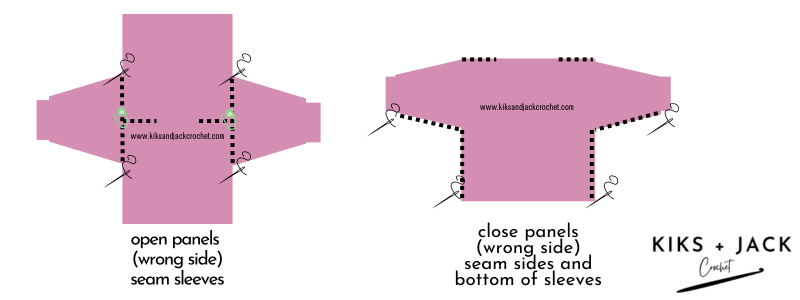
Fasten off.
Step 4: Add the crocheted edge to the neckline
Turn the sweater right side out. Attach a yarn to the side of the neckline.
Row 1: ch1, sc in the first st, sc evenly around the neckline into every st. The key is to keep the sc even. When you complete the round, sl st to join at the top of the tch.
Tip: It may be helpful to place a stitch marker into your first stitch so you can easily identify the start of the round.
Row 2: ch2, hdc in the first st, hdc around in each st, sl st to join at the top of the tch.
Repeat row 2 until you reach the desired thickness around the neckline. We wanted a thick yoke neckline and crocheted until it was approximately 3 inches thick.
Tip: Keep trying it on as you repeat row 2 so you can see how the sweater sits and whether you need to add additional rows of row 2 or if you should stop.
Fasten off.
Finish & Celebrate the Petra Easy Textured Crochet Sweater
Weave in all your ends.
Congratulations you have finished The Petra Easy Textured Crochet Sweater and I hope you enjoyed this free crochet pattern.
We are trying to keep all our crochet patterns free for everyone, when you access them online. We meet the costs of running this website through coffee donations at https://ko-fi.com/kiksandjackcrochet and ad revenue. When you buy us a cup of coffee, you buy us a cup of motivation. Thank you for keeping us motivated and inspired every day to keep designing free crochet patterns for you.
